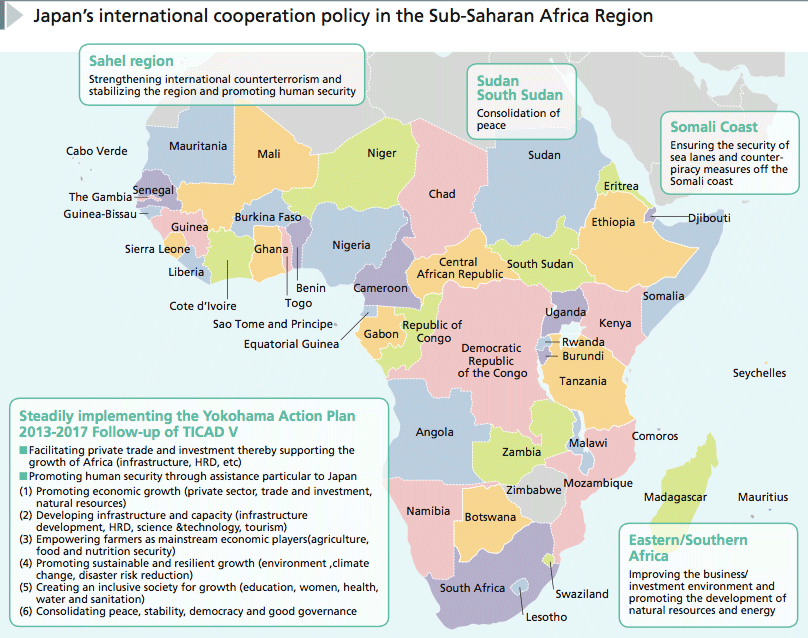5. Sub-Saharan Africa
Africa, in particular Sub-Saharan Africa, continues to face serious problems of poverty. The majority of Sub-Saharan African countries (34 out of 49 countries) are Least Developed Countries (LDCs), where approximately half of the population lives below the poverty line of “$1.25 per day”. In addition, many countries in the region face serious problems that hinder development, such as civil war and conflicts, refugees, famine resulting from drought, the spread of infectious diseases such as HIV/ AIDS, and require a significant amount of aid from the international community. These problems in Africa, which are discussed at such forums as the UN Security Council, are of grave concern to the international community.
At the same time, with abundant natural resources and an increasing population, Africa has achieved remarkable economic growth in recent years. It is drawing expectations and attention from the international community and is expanding its presence as a “future global growth center.” For over 20 years, through the Tokyo International Conference on African Development (TICAD) process spearheaded by Japan, Japan has proactively supported Africa's efforts to address development challenges, under the basic principle of ownership and partnership, whereby the international community extends support for Africa's own efforts.
< Japan's Efforts >
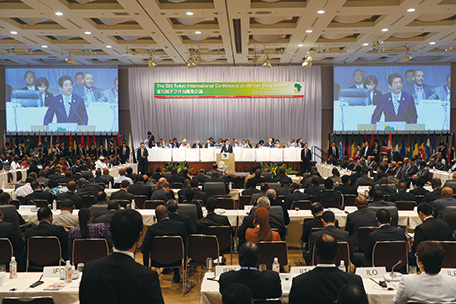
The closing ceremony of the TICAD V held in June 2013.

Women sorting out teff grain, the staple food of Ethiopia, by hand. (Photo: Takeshi Kuno / JICA)

Plateau district in central Abidjan, Côte d'Ivoire, is a business area where ministries and government offices, embassies, hotel and banks gather. (Photo: Msataka Otsuka / JICA)

Children heading to school through a rubber plantation in Liberia. (Photo: Yosuke Kotsuji)
In June 2013, 20 years after the launching of TICAD in 1993, TICAD V was held in Yokohama. TICAD V was joined by over 4,500 people from 51 African countries including 39 Heads of State, 31 development partner countries and Asian countries, 72 international organizations and representatives of regional organizations, and representatives of civil society such as the private sector and NGOs. The scale of the conference was larger than that of the previous TICAD meeting. It turned out to be the largest international conferences Japan had ever hosted.
Under the overarching theme of “Hand in Hand with a More Dynamic Africa,” active discussions were held on the core themes of “Robust and Sustainable Economy,” “Inclusive and Resilient Society,” and “Peace and Stability.” This led to the adoption of both the Yokohama Declaration 2013 that sets forth the future direction of Africa, and the Yokohama Action Plan 2013-2017 that identifies specific measures for the next five years. Furthermore, reflecting the importance of private sector led growth, a “Dialogue with the Private Sector” was held at the plenary session for the first time, allowing African leaders and representatives of the Japanese private sector to engage in direct dialogue.
In this conference, Japan focused on infrastructure and human resources development, and spelled out its assistance package for Africa. This consists of up to approximately ¥3.2 trillion worth of assistance from both the public and private sectors, including approximately ¥1.4 trillion of ODA; capacity building of people for business and industry, including the African Business Education Initiative for the Youth (ABE Initiative); and development/humanitarian assistance in the Sahel region.
As was promised at TICAD V, Prime Minister Shinzo Abe visited three African countries (Côte d'Ivoire, Mozambique and Ethiopia) in January 2014. In Côte d'Ivoire, the Prime Minister held talks with leaders who gathered from ten West African countries. In Mozambique, the Prime Minister announced an “Assistance package for Japan-Mozambique Mutual Growth,” centering on human resources development of more than 300 persons over five years as well as assistance of approximately ¥70 billion for the comprehensive development in the Nacala Corridor region and the surrounding area. In a policy speech delivered in Ethiopia, the Prime Minister focused on “each and every individual” in Africa, especially on the importance of women and young people for growth. Representatives of a total of 33 Japanese private companies, organizations, and universities accompanied the Prime Minister on his Africa visit and together with the Prime Minister, engaged in “top-level sales” and interaction with the aim of strengthening business relations with Africa.
At the First TICAD V Ministerial Meeting in Cameroon in May 2014, Japan reported on the steadfast implementation of Japan's assistance pledged at TICAD V. Many African countries expressed appreciation for Japan's assistance thus far. In August 2014, Japan dispatched its eighth Public and Private Sector Joint Mission for Promoting Trade and Investment for Africa to Ethiopia, Rwanda, and Tanzania. In September of the same year, Japan held the Japan-African Regional Economic Communities (RECs) Summit Roundtable in New York on the theme of infrastructure development. Through such initiatives, Japan has strengthened its relations with Africa.
Japan has also been contributing to efforts to achieve peace and stability in the African region. During his visit to Africa in January 2014, Prime Minister Shinzo Abe announced that Japan was prepared to implement assistance of $320 million in order to respond to conflicts and disasters, including helping the situation in South Sudan, the Sahel region, and Central Africa. In March of that year, Japan invited President Hassan Sheikh Mohamud of Somalia and held a Japan-Somalia Summit Meeting. Taking the opportunity of President Hassan's visit to Japan, Japan decided on a new assistance package for Somalia of approximately $40 million as well as the resumption of bilateral Grant Assistance for Grass-Roots Human Security Project. In addition, Prime Minister Abe communicated to President Hassan, Japan's intention to steadily implement assistance that would help each and every individual in Somalia including strengthening human resources development assistance. The leaders concurred that both countries would cooperate towards the stabilization of Somalia, including on counter-piracy measures, and by extension, towards the peace and prosperity of the East African region. Stability in Somalia is important for the stability and prosperity of East Africa. It is also essential for fundamentally resolving the problem of piracy off the coast of Somalia and ensuring the safety of one of the major sea lanes of transportation, one that plays a prominent role even on the global level, from the Indian Ocean into the Red Sea and then out through the Mediterranean Sea.
In February 2014, through the United Nations Asia and Far East Institute for the Prevention of Crime and the Treatment of Offenders (UNAFEI), Japan organized a training program for criminal justice practitioners in French-speaking African countries, focusing on themes such as effective criminal investigation, counter-terrorism investigation methods, and the capacity building of criminal justice officers. This training has contributed to the enhancement and development of the criminal justice system in French-speaking African countries, and thereby, addresses such challenges as the deteriorating security situation and the serious issue of corruption, which are also considered as challenges for the rest of the world.
| Senegal
Project on Promotion of Rural Development in Harmonization with Ecology and Economy: Promotion of Ecovillages
Technical cooperation for development planning (October 2012 – Ongoing)
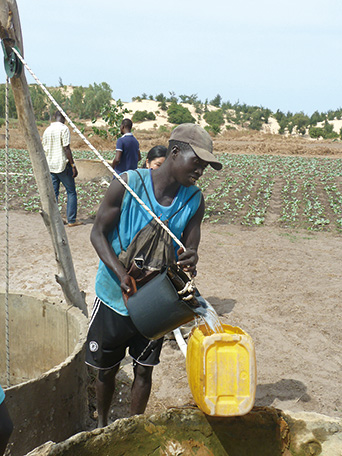
Taking advantage of the geographical characteristics in the Niayes Arrondissement, where ground-water level is shallow (about 10m), solar powered water pumps are installed in the aim to establish and diffuse efficient and economical farming. (Photo: JICA)
In Senegal, where 60% of the total population live in rural farming areas, many engage in farming or livestock breeding. Their lives depend heavily on the surrounding eco-system, and with the population increase, there is a marked tendency of limited resources there, such as forests and water, being used and consumed at a faster rate than they can be regenerated. This has created the problem of the vicious cycle of environmental degradation1, the decrease of agricultural productivity, and the further spread of poverty. In order to address this problem, the Government of Senegal announced the “National Program of Ecovillages2” in 2008, with the aim of developing sustainable villages in pursuit of both environment protection and economic goals, while creating more jobs in rural villages. However, the implementing agency of the program, the National Agency of Ecovillage, was not actually doing anything concrete to translate the plan into action.
In light of this situation, Japan has been collaborating with the National Agency of Ecovillage to promote this program by supporting the formulation of development plans and the implementation framework at the regional level in Senegal. In doing so, Japan supported the establishment of the “eco platform” that coordinates between central government ministries, such as the Ministry of Agriculture, and relevant regional offices, including those dealing with ecology and environment protection. Japan also supported the implementation of pilot projects in three regions with distinctively different ecosystems, namely, Louga, Fatick, and Thies. In each of these regions, as a pilot program, Japan is supporting the formulation and implementation of respective development project plans that reflect the respective needs of these regions in terms of resources and development. Under this pilot program, for example, in the Fatick region, residents around the mangrove forest along the coast, the survival of which has been in danger in recent years because of deforestation caused by intruders from outside the region, have been engaging in tree planting to regenerate the forest. As a result, fish and prawns are coming back to the mangrove forest. Another example of progress under this pilot program can be found in the northern Louga region, an area with a large nomadic population, where the use of “bio-digester,” which is a device that generates bio gas by using cattle manure as fuel, is being promoted.
In order to expand the implementation of the National Program of Ecovillages throughout the country in the future, the voluntary involvement of not only the central government but also regional governments is essential. Japan will continue to work on strengthening regional level coordination through the development of eco platforms, while promoting the development of ecovillages that reflect the voices of local communities.
(As of August 2014)
*1 It is estimated that 65% of cultivable land (2.5 million ha) has been affected by soil degradation. (Source: the First Year Completion Report of Project of Capacity Building for the Restoration and the Promotion of Effective Use of Degraded Soil in the Areas of Soil Degradation (CODEVAL))
*2 Highly sustainable community in three aspects: environment, economy, and society. Ecovillage development projects include an initiative to improve livelihoods through the use of natural energy.
| Mozambique
Nacala Corridor Development and Rehabilitation Program
Grant Aid, ODA Loans, Technical Cooperation Project, and others (March 2010 – Ongoing)
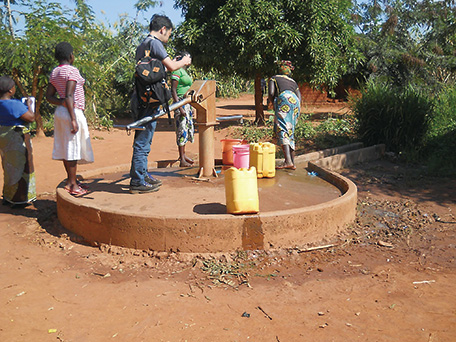
An expert, Mr. Hiroaki Kojima, checking the maintenance status of a facility built by another donor. About 30 of the similar type of deep well water supply facilities with hand pumps are also planned to be built through this project. (Photo: JICA)
The Nacala Corridor is the main artery in the region linking northern Mozambique and neighboring landlocked countries, including Malawi and Zambia. The Corridor's gateway is the Nacala Port in northern Mozambique that faces the Indian Ocean. The Nacala Corridor is essential both as a transport channel for Mozambique's abundant mineral and energy resources, and as a transportation route for agricultural products that have large potential gains if there is further agricultural development. In order to promote the development of the Nacala Corridor, Japan provides support to repair roads and bridges that connect the Corridor and surrounding areas, to maintain the Nacala Port, and to develop infrastructure, including power supply systems. Japan also actively engages in support for the agricultural development, education, and water supply sectors, as part of Japan's comprehensive assistance for the development of the Corridor. Such initiatives are collectively called the “Nacala Corridor Development and Rehabilitation Program.”
In the area of infrastructure development, Japan's ongoing projects include the ODA loan project, “Nampula - Cuamba Road Upgrading Project,” which is a project for improving a 350 km-section of a national road, and the grant aid project, “Project for Construction of Bridges on the Road between Ile and Cuamba,” a project to build new or to replace 13 bridges on the national road. As for assistance related to the education sector, Japan is implementing the grant aid project, “Project for the Construction of Secondary Schools in Nampula Province.” This project will build four new secondary schools (49 classrooms in total) and provide necessary supplies, including office and learning equipment, in Nampula Province, northern Mozambique, where the enrollment rate in secondary education is low.
Additionally, in regard to assistance related to water supply, Japan implements the “Project on Promoting Sustainability in Rural Water supply, Hygiene and Sanitation in Niassa Province.” This project aims to improve water supply, hygiene, and sanitation in Niassa Province, where large-scale support has never been implemented. Furthermore, the project endeavors to enhance capacities in planning, implementation, management, and monitoring of the Public Works Department of Niassa Province and other related agencies in Mozambique. By providing support in various sectors, Japan aims to make a contribution to the comprehensive development of the Nacala Corridor.
(As of August 2014)
| Sudan
Frontline Maternal and Child Health Empowerment Project Phase 2 (Mother Nile Project Phase 2)
Technical Cooperation Project (September 2011 – September 2014)
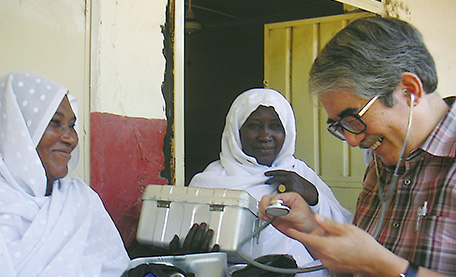
An expert, Mr. Yasuhide Nakamura (doctor), and village midwives checking necessary tools for check up. (Photo: JICA)
In Sudan in 2013, the maternal mortality rate was 360 deaths out of 100,000 live births, and the infant mortality rate was 51 deaths out of 1,000 live births, significantly exceeding the world average (210 deaths for the former, 34 deaths for the latter). Some of the causes include limited access to healthcare facilities and services by pregnant women, mothers, and newborn babies in rural areas, and the lack of human resources to provide the necessary medical services. Accordingly, it is an urgent task to improve maternal and child health1.
The goal of this project is to enable more women in Sudan to access high quality medical services for pregnancy and childbirth. The project provides support for enhancing the skills of village midwives (VMW) throughout Sudan, and for establishing a comprehensive model to improve the health of pregnant women and newborn babies in Sennar State.
As a result of this initiative, in Sennar State between 2011 and 2013, the number of prenatal care visits at healthcare facilities increased from 10,333 to 14,376, the number of deliveries at healthcare facilities increased from 9,421 to 14,227, and the number of prenatal checkups by VMWs increased from an average of 7.9 to 11.94 per month.
Through the project, the administrative capacities of the Federal Ministry of Health and the State Ministries of Health have increased, and progress was made in the development of a system to support VMWs. This is also evident from the numbers: the ratio of VMWs who are employed by the government in the whole country has increased from 3% (2010) to 23% (2012). With respect to the training of healthcare workers, this project (Phase 2) and the previous project (Phase 1) fostered a total of 163 in-service training instructors and associate instructors, and 2,735 VMWs, which is equivalent to 21% of the country's VMWs, as part of the efforts to enhance their capabilities. It is expected that maternal and child health will be further improved through continuous support for VMWs.
*1 (Source) UN Maternal Mortality Estimation Inter-agency Group (MMEIG)
